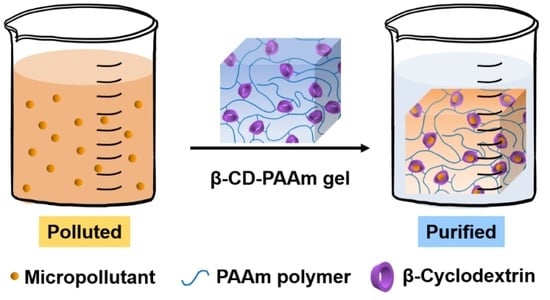β-Cyclodextrin-Polyacrylamide Hydrogel for Removal of Organic Micropollutants from Water
Abstract
:1. Introduction
2. Experimental Section
2.1. Materials
2.2. Synthesis of β-Cyclodextrin-Methacrylate (β-CD-MA)
2.3. Synthesis of β-Cyclodextrin-Polyacrylamide (β-CD-PAAm) Gel
2.4. Synthesis of Polyacrylamide (PAAm) Gel
2.5. Characterizations
2.6. Swelling Studies
2.7. Kinetic Studies of Pollutant Removal
2.8. Thermodynamic Studies of Pollutant Removal
2.9. Hydrogel Recycling Studies
3. Results and Discussion
3.1. Synthesis of β-Cyclodextrin-Methacrylate
3.2. Synthesis and Characterizations of Hydrogels
3.3. Kinetic Studies of Pollutant Removal
3.4. Thermodynamic Studies of Pollutant Removal
3.5. Hydrogel Recycling Studies
4. Conclusions
Supplementary Materials
Author Contributions
Funding
Data Availability Statement
Conflicts of Interest
Sample Availability
References
- Crini, G. Recent developments in polysaccharide-based materials used as adsorbents in wastewater treatment. Prog. Polym. Sci. 2005, 30, 38–70. [Google Scholar] [CrossRef]
- Luo, Y.; Guo, W.; Ngo, H.H.; Nghiem, L.D.; Hai, F.I.; Zhang, J.; Liang, S.; Wang, X.C. A review on the occurrence of micropollutants in the aquatic environment and their fate and removal during wastewater treatment. Sci. Total Environ. 2014, 473–474, 619–641. [Google Scholar] [CrossRef]
- Kang, J.-H.; Aasi, D.; Katayama, Y. Bisphenol A in the Aquatic Environment and Its Endocrine-Disruptive Effects on Aquatic Organisms. Crit. Rev. Toxicol. 2007, 37, 607–625. [Google Scholar] [CrossRef] [PubMed]
- Maszkowska, J.; Stolte, S.; Kumirska, J.; Łukaszewicz, P.; Mioduszewska, K.; Puckowski, A.; Caban, M.; Wagil, M.; Stepnowski, P.; Białk-Bielińska, A. Beta-blockers in the environment: Part II. Ecotoxicity study. Sci. Total Environ. 2014, 493, 1122–1126. [Google Scholar] [CrossRef] [PubMed]
- Krugly, E.; Martuzevicius, D.; Tichonovas, M.; Jankunaite, D.; Rumskaite, I.; Sedlina, J.; Racys, V.; Baltrusaitis, J. Decomposition of 2-naphthol in water using a non-thermal plasma reactor. Chem. Eng. J. 2015, 260, 188–198. [Google Scholar] [CrossRef]
- Richardson, S.D.; Ternes, T.A. Water Analysis: Emerging Contaminants and Current Issues. Anal. Chem. 2018, 90, 398–428. [Google Scholar] [CrossRef] [PubMed]
- Murray, K.E.; Thomas, S.M.; Bodour, A.A. Prioritizing research for trace pollutants and emerging contaminants in the freshwater environment. Environ. Pollut. 2010, 158, 3462–3471. [Google Scholar] [CrossRef] [PubMed]
- Bhatnagar, A.; Anastopoulos, I. Adsorptive removal of bisphenol A (BPA) from aqueous solution: A review. Chemosphere 2017, 168, 885–902. [Google Scholar] [CrossRef] [PubMed]
- Grassi, M.; Rizzo, L.; Farina, A. Endocrine disruptors compounds, pharmaceuticals and personal care products in urban wastewater: Implications for agricultural reuse and their removal by adsorption process. Environ. Sci. Pollut. Res. 2013, 20, 3616–3628. [Google Scholar] [CrossRef] [PubMed]
- Brown, N.W.; Roberts, E.P.L.; Garforth, A.A.; Dryfe, R.A.W. Electrochemical regeneration of a carbon-based adsorbent loaded with crystal violet dye. Electrochim. Acta 2004, 49, 3269–3281. [Google Scholar] [CrossRef]
- San Miguel, G.; Lambert, S.D.; Graham, N.J.D. The regeneration of field-spent granular-activated carbons. Water Res. 2001, 35, 2740–2748. [Google Scholar] [CrossRef]
- Park, J.E.; Lee, G.B.; Hong, B.U.; Hwang, S.Y. Regeneration of Activated Carbons Spent by Waste Water Treatment Using KOH Chemical Activation. Appl. Sci. 2019, 9, 5132. [Google Scholar] [CrossRef] [Green Version]
- Larasati, A.; Fowler, G.D.; Graham, N.J.D. Chemical regeneration of granular activated carbon: Preliminary evaluation of alternative regenerant solutions. Environ. Sci. Water Res. Technol. 2020, 6, 2043–2056. [Google Scholar] [CrossRef]
- Li, J.; Loh, X.J. Cyclodextrin-based supramolecular architectures: Syntheses, structures, and applications for drug and gene delivery. Adv. Drug Deliv. Rev. 2008, 60, 1000–1017. [Google Scholar] [CrossRef]
- Wen, Y.; Zhang, Z.; Li, J. Highly Efficient Multifunctional Supramolecular Gene Carrier System Self-Assembled from Redox-Sensitive and Zwitterionic Polymer Blocks. Adv. Funct. Mater. 2014, 24, 3874–3884. [Google Scholar] [CrossRef]
- Zhu, J.-L.; Liu, K.L.; Wen, Y.; Song, X.; Li, J. Host–guest interaction induced supramolecular amphiphilic star architecture and uniform nanovesicle formation for anticancer drug delivery. Nanoscale 2016, 8, 1332–1337. [Google Scholar] [CrossRef] [PubMed]
- Song, X.; Wen, Y.; Zhu, J.-L.; Zhao, F.; Zhang, Z.-X.; Li, J. Thermoresponsive Delivery of Paclitaxel by β-Cyclodextrin-Based Poly(N-isopropylacrylamide) Star Polymer via Inclusion Complexation. Biomacromolecules 2016, 17, 3957–3963. [Google Scholar] [CrossRef] [PubMed]
- Ooi, Y.J.; Wen, Y.; Zhu, J.; Song, X.; Li, J. Surface Charge Switchable Polymer/DNA Nanoparticles Responsive to Tumor Extracellular pH for Tumor-Triggered Enhanced Gene Delivery. Biomacromolecules 2020, 21, 1136–1148. [Google Scholar] [CrossRef] [PubMed]
- Li, Z.; Van Guyse, J.F.R.; de la Rosa, V.R.; Van Gorp, H.; Walke, P.; Rodríguez González, M.C.; Uji-i, H.; Hoogenboom, R.; De Feyter, S.; Mertens, S.F.L. One-Step Covalent Immobilization of β-Cyclodextrin on sp2 Carbon Surfaces for Selective Trace Amount Probing of Guests. Adv. Funct. Mater. 2019, 29, 1901488. [Google Scholar] [CrossRef]
- Li, S.; Liang, N.; Yan, P.; Kawashima, Y.; Sun, S. Inclusion complex based on N-acetyl-L-cysteine and arginine modified hydroxypropyl-β-cyclodextrin for oral insulin delivery. Carbohydr. Polym. 2021, 252, 117202. [Google Scholar] [CrossRef]
- Chen, L.; Dong, Q.; Shi, Q.; Du, Y.; Zeng, Q.; Zhao, Y.; Wang, J.J. Novel 2,3-Dialdehyde Cellulose-Based Films with Photodynamic Inactivation Potency by Incorporating the β-Cyclodextrin/Curcumin Inclusion Complex. Biomacromolecules 2021, 22, 2790–2801. [Google Scholar] [CrossRef] [PubMed]
- Kitano, H.; Endo, H.; Gemmei-Ide, M.; Kyogoku, M. Inclusion of Bisphenols by Cyclodextrin Derivatives. J. Incl. Phenom. Macrocycl. Chem. 2003, 47, 83–90. [Google Scholar] [CrossRef]
- Castronuovo, G.; Niccoli, M. Thermodynamics of inclusion complexes of natural and modified cyclodextrins with propranolol in aqueous solution at 298K. Bioorg. Med. Chem. 2006, 14, 3883–3887. [Google Scholar] [CrossRef]
- Bisby, R.H.; Botchway, S.W.; Crisostomo, A.G.; Karolin, J.; Parker, A.W.; Schröder, L. Interactions of the β-blocker drug, propranolol, with detergents, β-cyclodextrin and living cells studied using fluorescence spectroscopy and imaging. Spectroscopy 2010, 24, 129574. [Google Scholar] [CrossRef]
- van Stam, J.; De Feyter, S.; De Schryver, F.C.; Evans, C.H. 2-Naphthol Complexation by β-Cyclodextrin: Influence of Added Short Linear Alcohols. J. Phys. Chem. 1996, 100, 19959–19966. [Google Scholar] [CrossRef]
- Zarzycki, P.K.; Lamparczyk, H. The equilibrium constant of β-cyclodextrin–phenolphtalein complex; influence of temperature and tetrahydrofuran addition1Presented at the 7th Meeting on Recent Developments in Pharmaceutical Analysis, Island of Elba, Italy, September 16–20, 1997.1. J. Pharm. Biomed. Anal. 1998, 18, 165–170. [Google Scholar] [CrossRef]
- Wang, T.; Li, B.; Si, H.; Lin, L. Investigation on surface activity of cyclodextrins grafting cellulose beads through phenolphthalein probe molecule. Surf. Interface Anal. 2011, 43, 1532–1538. [Google Scholar] [CrossRef]
- Alsbaiee, A.; Smith, B.J.; Xiao, L.; Ling, Y.; Helbling, D.E.; Dichtel, W.R. Rapid removal of organic micropollutants from water by a porous β-cyclodextrin polymer. Nature 2016, 529, 190–194. [Google Scholar] [CrossRef]
- Wang, Z.; Zhang, P.; Hu, F.; Zhao, Y.; Zhu, L. A crosslinked β-cyclodextrin polymer used for rapid removal of a broad-spectrum of organic micropollutants from water. Carbohydr. Polym. 2017, 177, 224–231. [Google Scholar] [CrossRef]
- Kono, H.; Nakamura, T.; Hashimoto, H.; Shimizu, Y. Characterization, molecular dynamics, and encapsulation ability of β-cyclodextrin polymers crosslinked by polyethylene glycol. Carbohydr. Polym. 2015, 128, 11–23. [Google Scholar] [CrossRef] [PubMed] [Green Version]
- Kitaoka, M.; Hayashi, K. Adsorption of Bisphenol A by Cross-Linked β-Cyclodextrin Polymer. J. Incl. Phenom. Macrocycl. Chem. 2002, 44, 429–431. [Google Scholar] [CrossRef]
- Li, X.; Zhou, M.; Jia, J.; Ma, J.; Jia, Q. Design of a hyper-crosslinked β-cyclodextrin porous polymer for highly efficient removal toward bisphenol a from water. Sep. Purif. Technol. 2018, 195, 130–137. [Google Scholar] [CrossRef]
- Hu, X.; Hu, Y.; Xu, G.; Li, M.; Zhu, Y.; Jiang, L.; Tu, Y.; Zhu, X.; Xie, X.; Li, A. Green synthesis of a magnetic β-cyclodextrin polymer for rapid removal of organic micro-pollutants and heavy metals from dyeing wastewater. Environ. Res. 2020, 180, 108796. [Google Scholar] [CrossRef]
- Yu, J.C.; Jiang, Z.-T.; Liu, H.-Y.; Yu, J.; Zhang, L. β-Cyclodextrin epichlorohydrin copolymer as a solid-phase extraction adsorbent for aromatic compounds in water samples. Anal. Chim. Acta 2003, 477, 93–101. [Google Scholar] [CrossRef]
- Morin-Crini, N.; Winterton, P.; Fourmentin, S.; Wilson, L.D.; Fenyvesi, É.; Crini, G. Water-insoluble β-cyclodextrin–epichlorohydrin polymers for removal of pollutants from aqueous solutions by sorption processes using batch studies: A review of inclusion mechanisms. Prog. Polym. Sci. 2018, 78, 1–23. [Google Scholar] [CrossRef]
- Hu, X.; Xu, G.; Zhang, H.; Li, M.; Tu, Y.; Xie, X.; Zhu, Y.; Jiang, L.; Zhu, X.; Ji, X.; et al. Multifunctional β-Cyclodextrin Polymer for Simultaneous Removal of Natural Organic Matter and Organic Micropollutants and Detrimental Microorganisms from Water. ACS Appl. Mater. Interfaces 2020, 12, 12165–12175. [Google Scholar] [CrossRef] [PubMed]
- Gupta, V.K.; Agarwal, S.; Sadegh, H.; Ali, G.A.M.; Bharti, A.K.; Hamdy Makhlouf, A.S. Facile route synthesis of novel graphene oxide-β-cyclodextrin nanocomposite and its application as adsorbent for removal of toxic bisphenol A from the aqueous phase. J. Mol. Liq. 2017, 237, 466–472. [Google Scholar] [CrossRef] [Green Version]
- Carvalho, L.B.; Chagas, P.M.B.; Marques, T.R.; Razafitianamaharavo, A.; Pelletier, M.; Nolis, P.; Jaime, C.; Thomasi, S.S.; Pinto, L.d.M.A. Removal of the synthetic hormone methyltestosterone from aqueous solution using a β-cyclodextrin/silica composite. J. Environ. Chem. Eng. 2019, 7, 103492. [Google Scholar] [CrossRef]
- Peppas, N.A.; Hilt, J.Z.; Khademhosseini, A.; Langer, R. Hydrogels in Biology and Medicine: From Molecular Principles to Bionanotechnology. Adv. Mater. 2006, 18, 1345–1360. [Google Scholar] [CrossRef]
- Jayakumar, A.; Jose, V.K.; Lee, J.-M. Hydrogels for Medical and Environmental Applications. Small Methods 2020, 4, 1900735. [Google Scholar] [CrossRef]
- de Souza, Í.F.T.; Petri, D.F.S. β-Cyclodextrin hydroxypropyl methylcellulose hydrogels for bisphenol A adsorption. J. Mol. Liq. 2018, 266, 640–648. [Google Scholar] [CrossRef]
- Kono, H.; Onishi, K.; Nakamura, T. Characterization and bisphenol A adsorption capacity of β-cyclodextrin–carboxymethylcellulose-based hydrogels. Carbohydr. Polym. 2013, 98, 784–792. [Google Scholar] [CrossRef] [PubMed]
- Hou, N.; Wang, R.; Geng, R.; Wang, F.; Jiao, T.; Zhang, L.; Zhou, J.; Bai, Z.; Peng, Q. Facile preparation of self-assembled hydrogels constructed from poly-cyclodextrin and poly-adamantane as highly selective adsorbents for wastewater treatment. Soft Matter 2019, 15, 6097–6106. [Google Scholar] [CrossRef] [PubMed]
- Xiong, B.; Loss, R.D.; Shields, D.; Pawlik, T.; Hochreiter, R.; Zydney, A.L.; Kumar, M. Polyacrylamide degradation and its implications in environmental systems. Npj Clean Water 2018, 1, 17. [Google Scholar] [CrossRef]
- Caulfield, M.J.; Hao, X.; Qiao, G.G.; Solomon, D.H. Degradation on polyacrylamides. Part II. Polyacrylamide gels. Polymer 2003, 44, 3817–3826. [Google Scholar] [CrossRef]
- Yang, C.; Yin, T.; Suo, Z. Polyacrylamide hydrogels. I. Network imperfection. J. Mech. Phys. Solids 2019, 131, 43–55. [Google Scholar] [CrossRef]
- Kettel, M.J.; Schaefer, K.; Pich, A.; Moeller, M. Functional PMMA nanogels by cross-linking with cyclodextrin methacrylate. Polymer 2016, 86, 176–188. [Google Scholar] [CrossRef]
- Kettel, M.J.; Dierkes, F.; Schaefer, K.; Moeller, M.; Pich, A. Aqueous nanogels modified with cyclodextrin. Polymer 2011, 52, 1917–1924. [Google Scholar] [CrossRef]
- Jindrich, J.; Pitha, J.; Lindberg, B. Separation of cyclodextrins and their derivatives by thin-layer and preparative column chromatography. Carbohydr. Res. 1995, 275, 1–7. [Google Scholar] [CrossRef]
- Harada, A.; Kobayashi, R.; Takashima, Y.; Hashidzume, A.; Yamaguchi, H. Macroscopic self-assembly through molecular recognition. Nat. Chem. 2011, 3, 34–37. [Google Scholar] [CrossRef]
- Zhang, Z.-X.; Liu, X.; Xu, F.J.; Loh, X.J.; Kang, E.-T.; Neoh, K.-G.; Li, J. Pseudo-Block Copolymer Based on Star-Shaped Poly(N-isopropylacrylamide) with a β-Cyclodextrin Core and Guest-Bearing PEG: Controlling Thermoresponsivity through Supramolecular Self-Assembly. Macromolecules 2008, 41, 5967–5970. [Google Scholar] [CrossRef]
- Li, X.; Zhao, Y.; Wang, K.; Wang, L.; Yang, X.; Zhu, S. Cyclodextrin-containing hydrogels as an intraocular lens for sustained drug release. PLoS ONE 2017, 12, e0189778. [Google Scholar] [CrossRef] [PubMed] [Green Version]
- Liu, M.; Li, W.; Rong, J.; Zhou, C. Novel polymer nanocomposite hydrogel with natural clay nanotubes. Colloid Polym. Sci. 2012, 290, 895–905. [Google Scholar] [CrossRef]
- Wu, H.; Kong, J.; Yao, X.; Zhao, C.; Dong, Y.; Lu, X. Polydopamine-assisted attachment of β-cyclodextrin on porous electrospun fibers for water purification under highly basic condition. Chem. Eng. J. 2015, 270, 101–109. [Google Scholar] [CrossRef]
- Taguchi, K. Transient binding of phenolphthalein-β-cyclodextrin complex: An example of induced geometrical distortion. J. Am. Chem. Soc. 1986, 108, 2705–2709. [Google Scholar] [CrossRef]
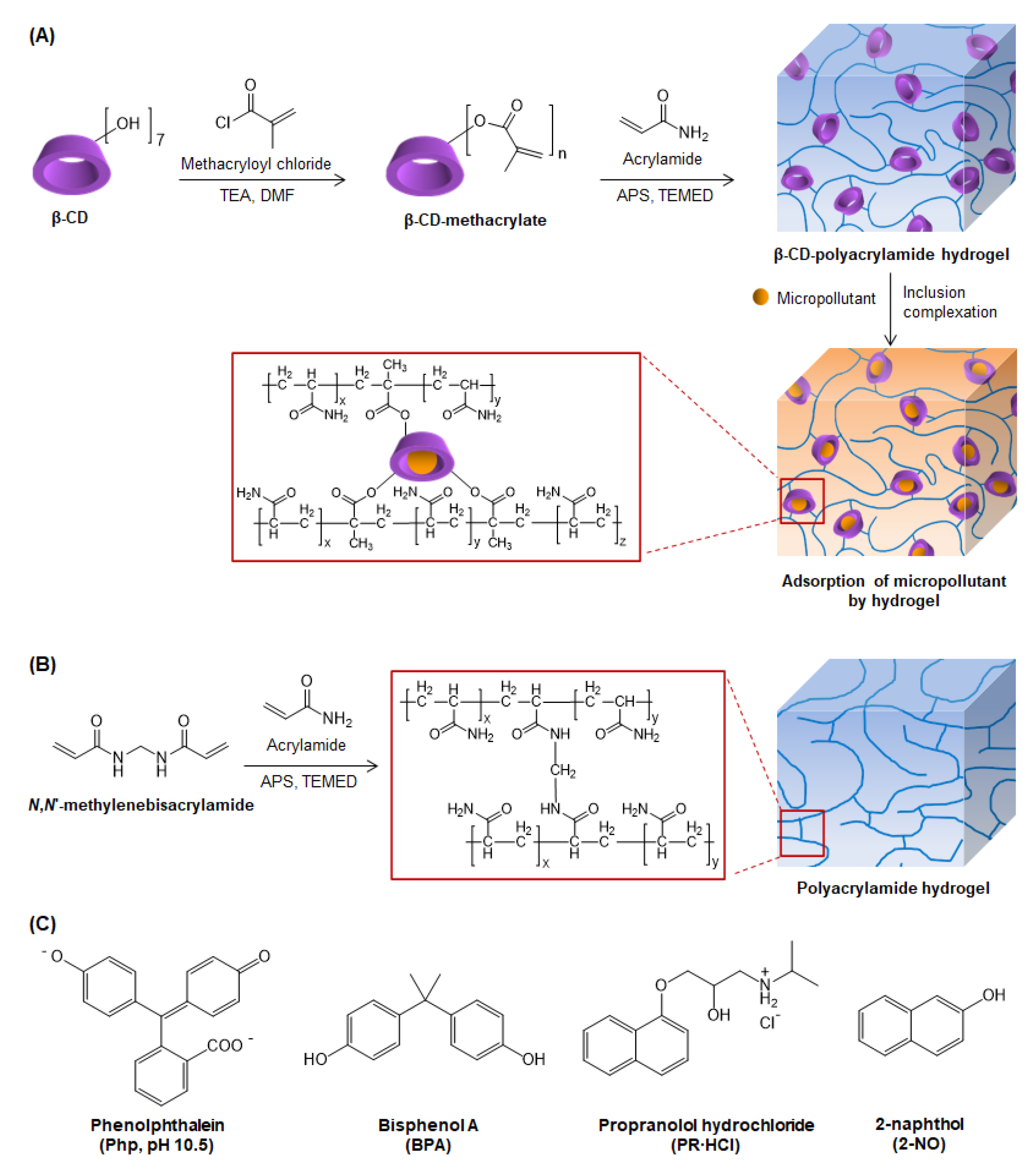
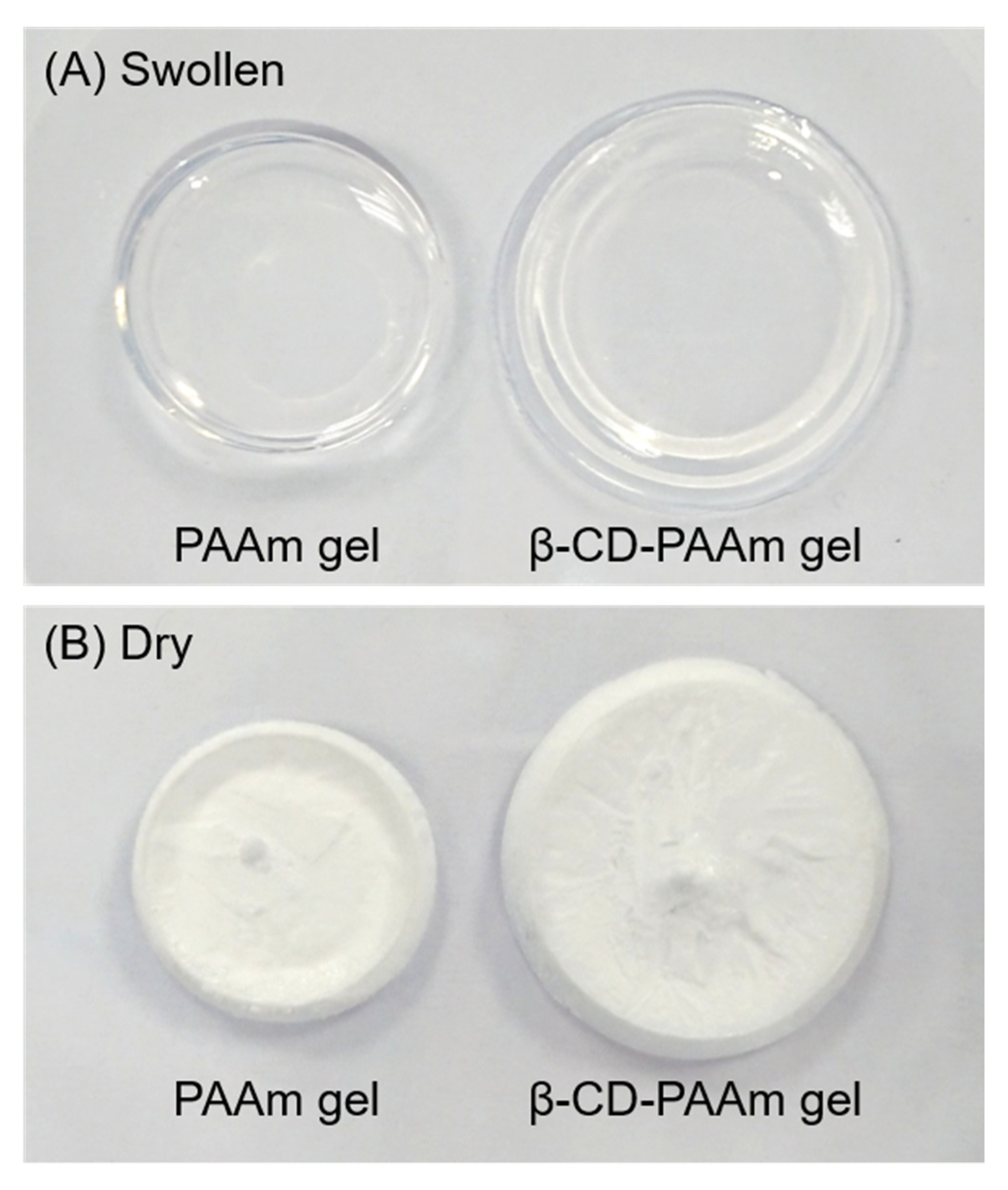
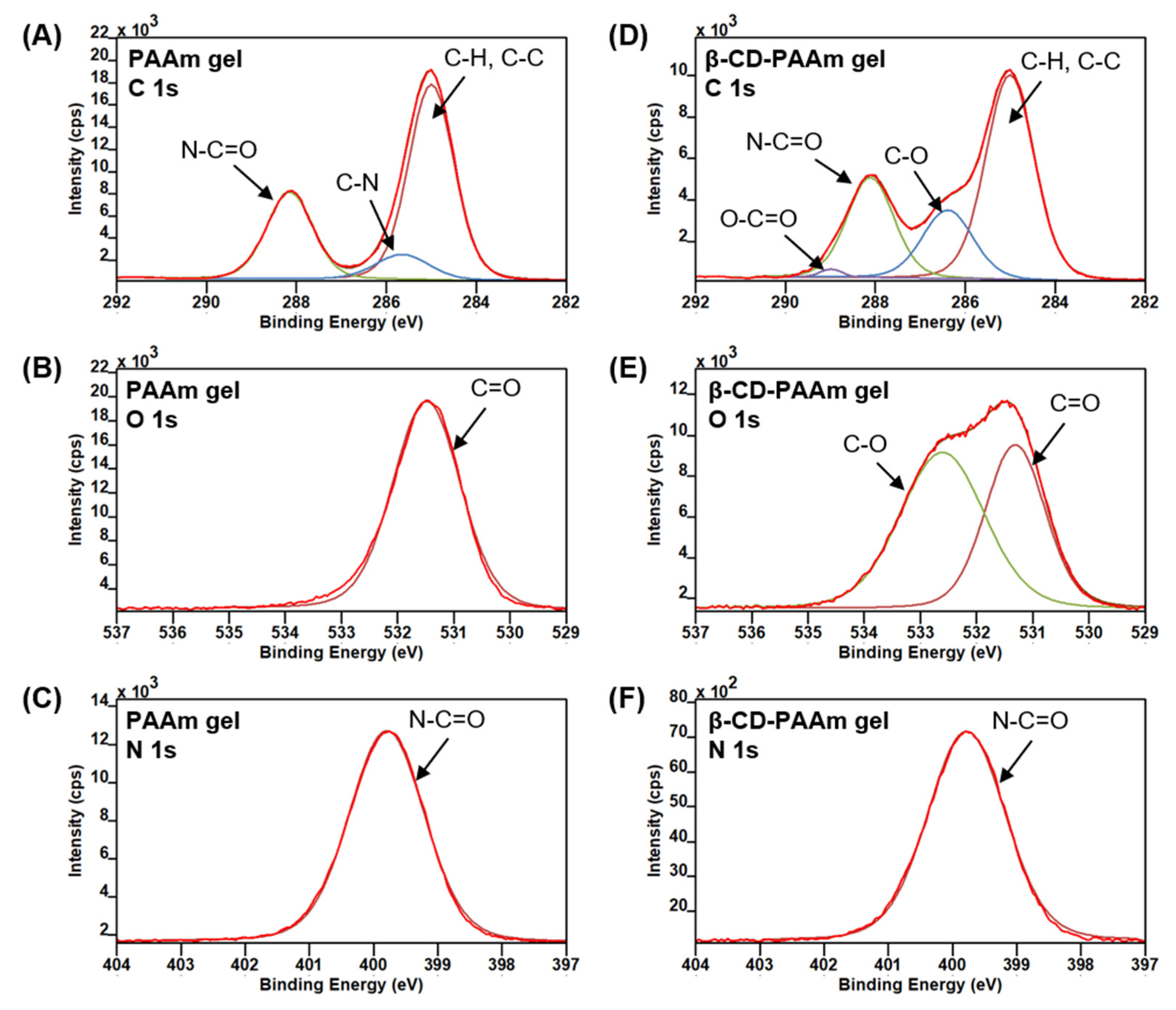

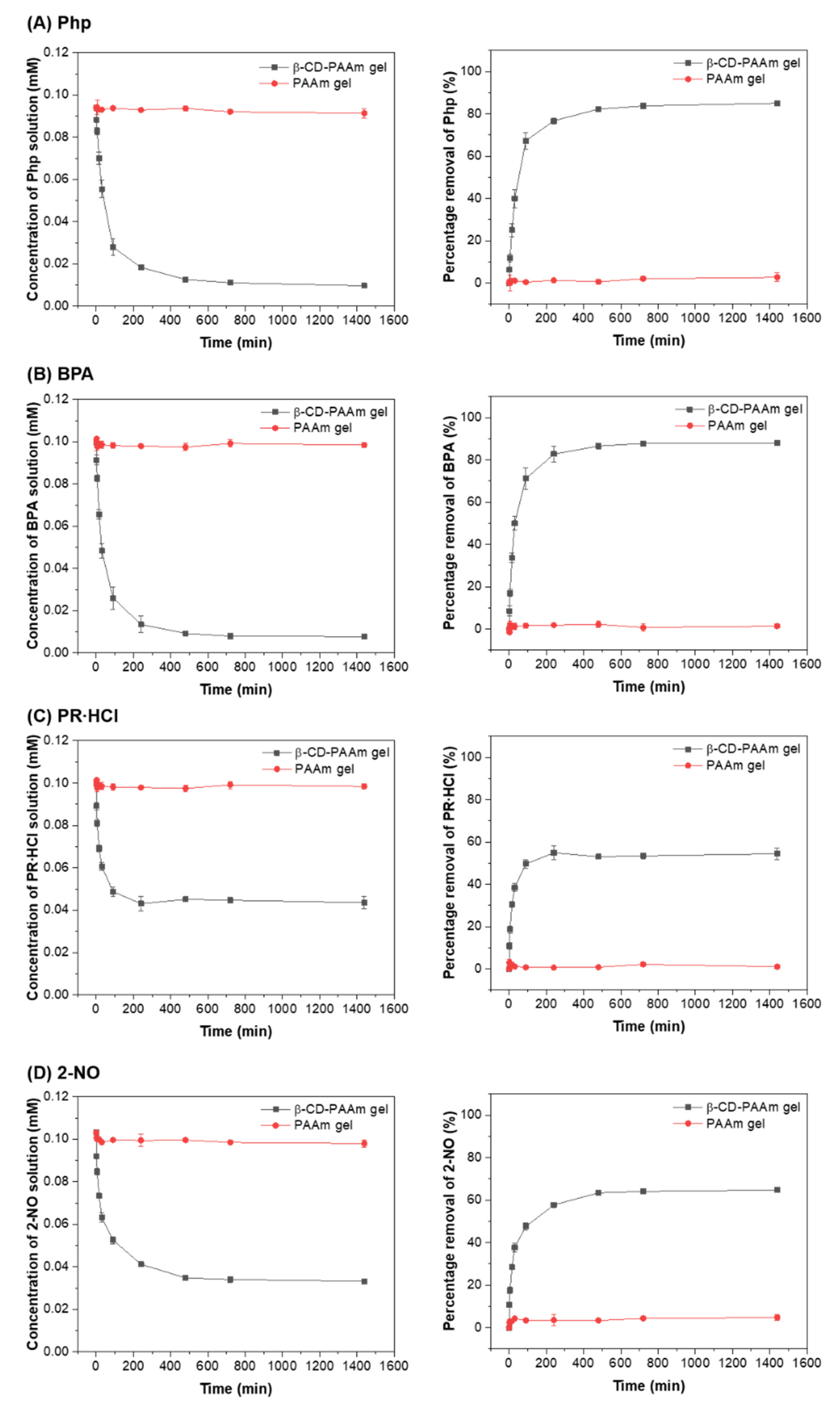
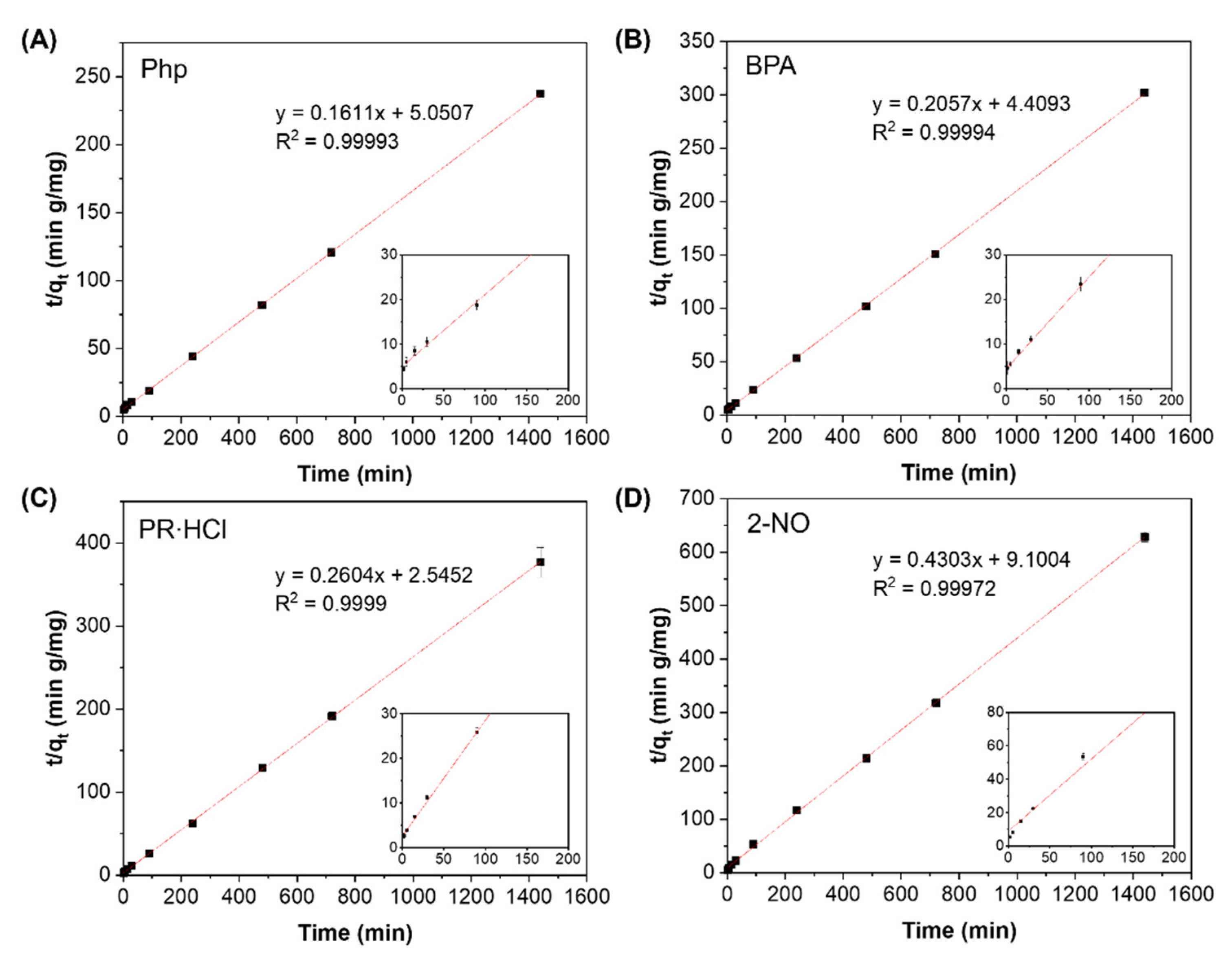
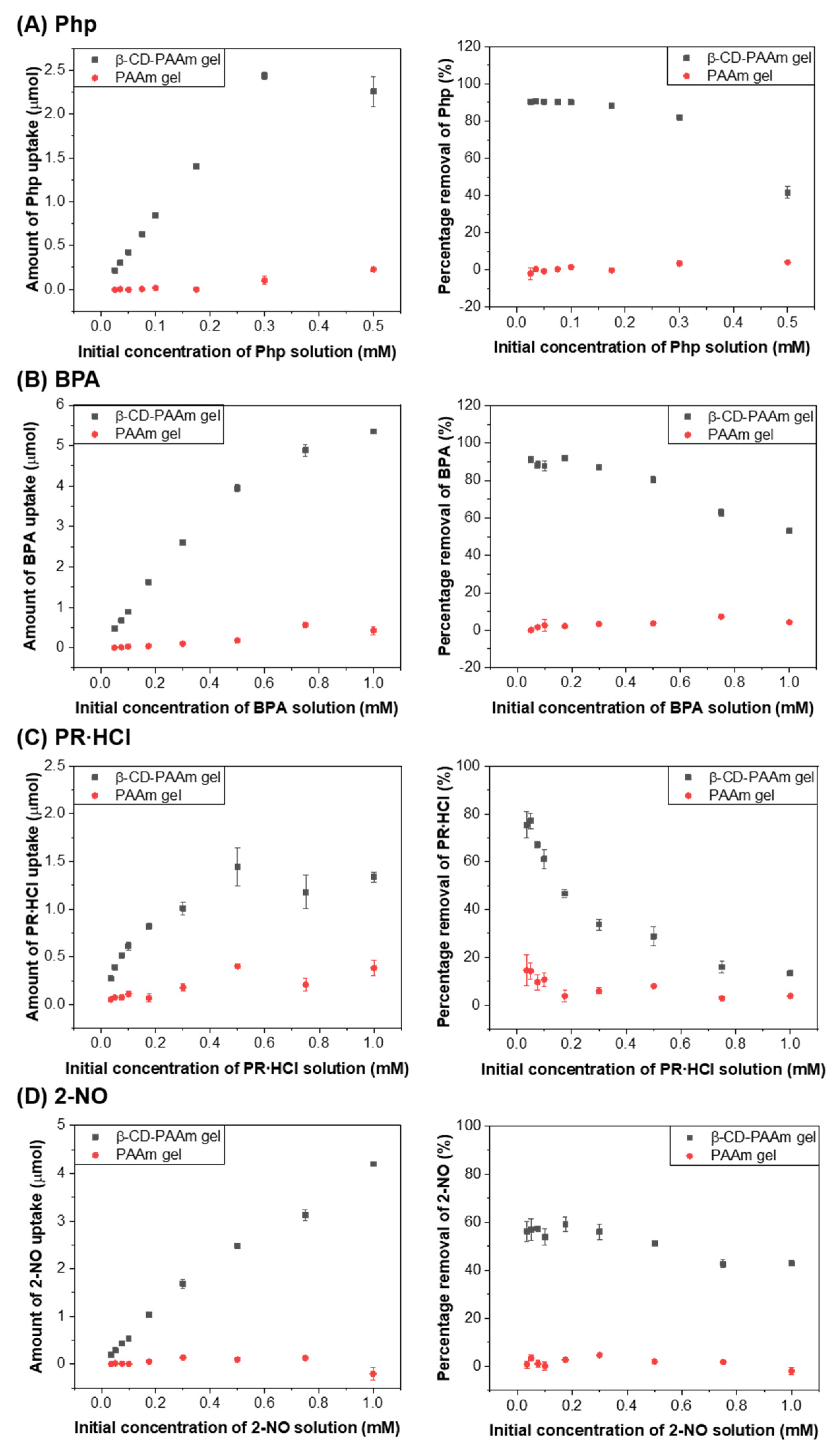
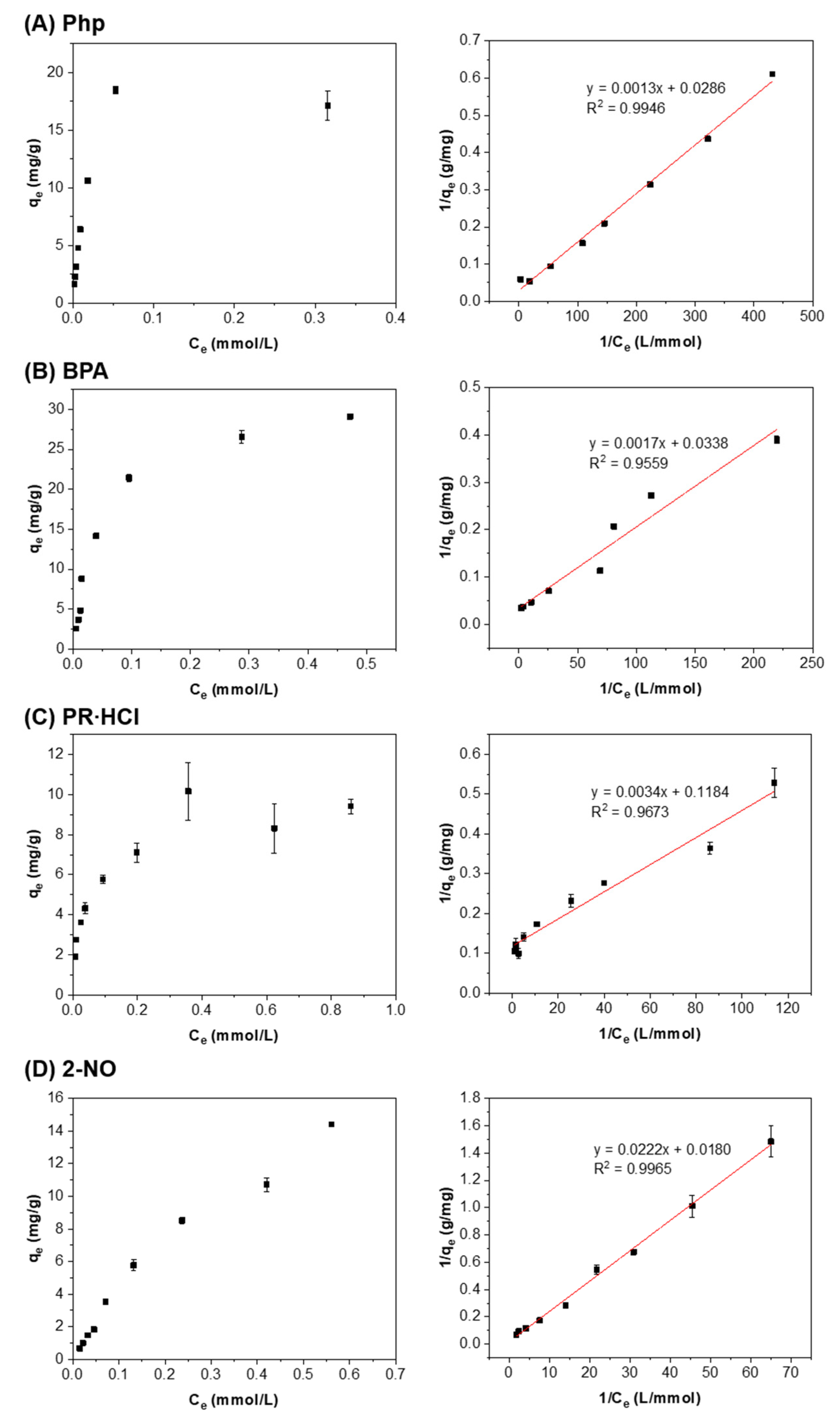

| Sample | Atomic Concentration (%) | ||
|---|---|---|---|
| C | O | N | |
| PAAm gel | 65.72 | 17.11 | 17.17 |
| β-CD-PAAm gel | 64.42 | 22.01 | 13.57 |
| Sample | Weight (mg) | Swelling Ratio | |
|---|---|---|---|
| Swollen (Ws) | Dry (Wd) | ||
| PAAm gel | 590.1 ± 22.3 | 43.1 ± 1.0 | 12.7 ± 0.6 |
| β-CD-PAAm gel | 1272.3 ± 45.4 | 42.0 ± 2.6 | 29.4 ± 2.4 |
| Pollutant | MW | k2 (g/mg min) | Correlation Coefficient R2 | qe,cal (mg/g) | qe,exp (mg/g) |
|---|---|---|---|---|---|
| Php | 318.32 | 0.0051 | 0.9999 | 6.21 | 6.07 |
| BPA | 228.29 | 0.0096 | 0.9999 | 4.86 | 4.78 |
| PR·HCl | 295.80 | 0.0266 | 0.9999 | 3.84 | 3.83 |
| 2-NO | 144.17 | 0.0203 | 0.9997 | 2.32 | 2.29 |
| Pollutant | K (M−1) | Correlation Coefficient R2 | qmax,e (mg/g) |
|---|---|---|---|
| Php | 22,000 | 0.9946 | 34.97 |
| BPA | 19,882 | 0.9559 | 29.59 |
| PR·HCl | 34,824 | 0.9673 | 8.45 |
| 2-NO | 811 | 0.9965 | 55.56 |
Publisher’s Note: MDPI stays neutral with regard to jurisdictional claims in published maps and institutional affiliations. |
© 2021 by the authors. Licensee MDPI, Basel, Switzerland. This article is an open access article distributed under the terms and conditions of the Creative Commons Attribution (CC BY) license (https://creativecommons.org/licenses/by/4.0/).
Share and Cite
Song, X.; Mensah, N.N.; Wen, Y.; Zhu, J.; Zhang, Z.; Tan, W.S.; Chen, X.; Li, J. β-Cyclodextrin-Polyacrylamide Hydrogel for Removal of Organic Micropollutants from Water. Molecules 2021, 26, 5031. https://doi.org/10.3390/molecules26165031
Song X, Mensah NN, Wen Y, Zhu J, Zhang Z, Tan WS, Chen X, Li J. β-Cyclodextrin-Polyacrylamide Hydrogel for Removal of Organic Micropollutants from Water. Molecules. 2021; 26(16):5031. https://doi.org/10.3390/molecules26165031
Chicago/Turabian StyleSong, Xia, Nana Nyarko Mensah, Yuting Wen, Jingling Zhu, Zhongxing Zhang, Wui Siew Tan, Xinwei Chen, and Jun Li. 2021. "β-Cyclodextrin-Polyacrylamide Hydrogel for Removal of Organic Micropollutants from Water" Molecules 26, no. 16: 5031. https://doi.org/10.3390/molecules26165031
APA StyleSong, X., Mensah, N. N., Wen, Y., Zhu, J., Zhang, Z., Tan, W. S., Chen, X., & Li, J. (2021). β-Cyclodextrin-Polyacrylamide Hydrogel for Removal of Organic Micropollutants from Water. Molecules, 26(16), 5031. https://doi.org/10.3390/molecules26165031






